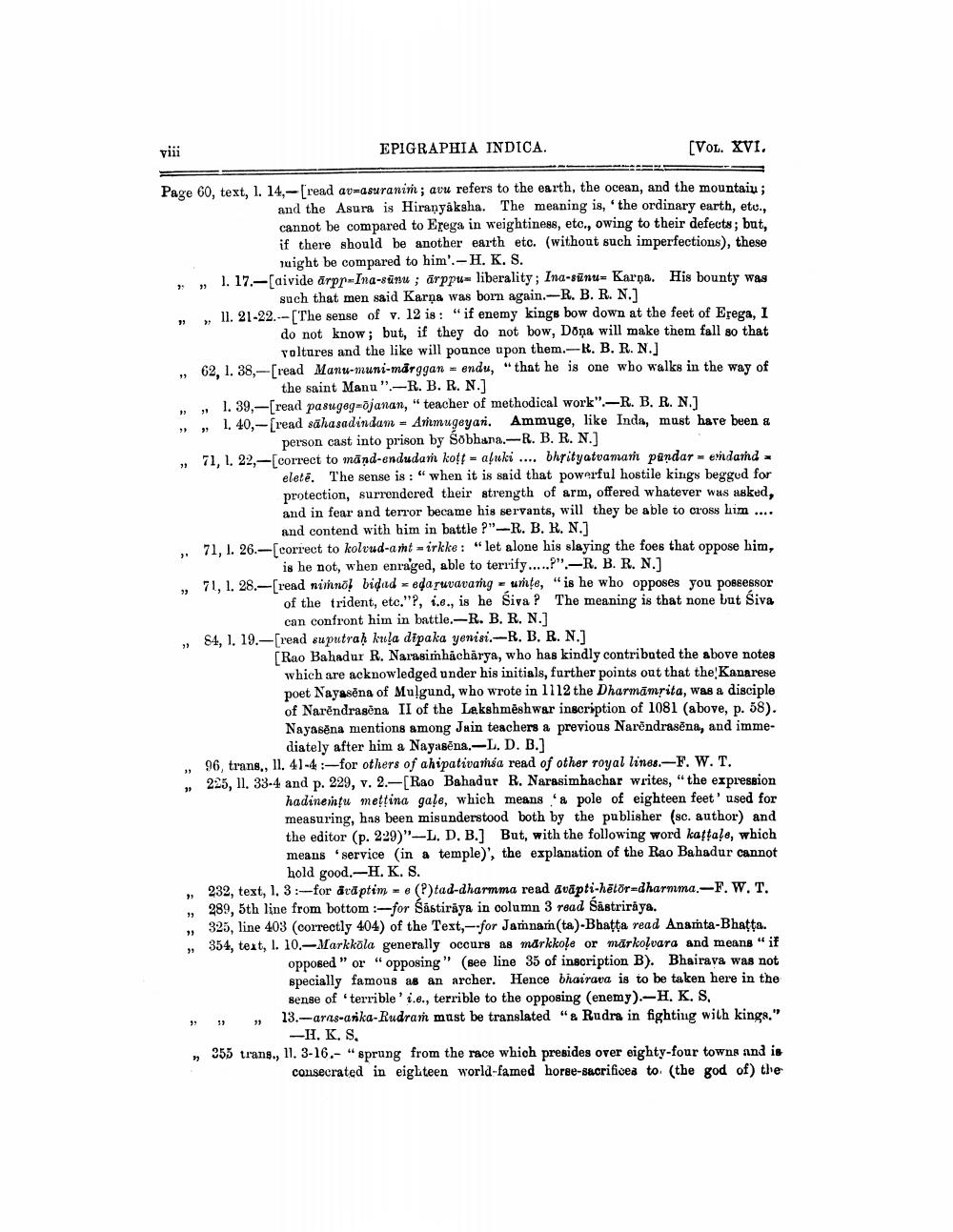________________
viii
EPIGRAPHIA INDICA.
(VOL. XVI.
Page 60, text, 1. 14,- [read av=asuranim ; avu refers to the earth, the ocean, and the mountaiu;
and the Asura is Hiranyáksha. The meaning is, the ordinary earth, etu.. cannot be compared to Erega in weightiness, etc., owing to their defects; but, if there should be another earth etc. (without such imperfections), these
vuight be compared to him'.-H. K. S. 1. 17.-[divide arpr Ina-sūnu; ārppu= liberality; Ina-sūnu. Karna. His bounty was
such that men said Karna was born again.-R. B.R. N.] , 11. 21-22.--[The sense of v. 12 is: "if enemy kings bow down at the feet of Erega, I
do not know; but, if they do not bow, Doņa will make them fall so that
voltures and the like will pounce upon them.-R. B.R.N.] .. 62, 1. 38,--[read Manu-muni-márggan = endu, " that he is one who walks in the way of
the saint Manu".-R. B. R. N.] ... 1.39,-[read pasugog-ājanan," teacher of methodical work"-R. B.R. N.1 . 1. 40,-read sähasadindam = Armugeyar. Ammuge, like Inda, must hare been &
person cast into prison by Sobhana.-R. B. R. N.] , 71, 1.22,-[correct to mānd-endudari kott = aluki .... bhrityatvamam pandar = e ndard
eletē. The sense is : " when it is said that powerful hostile kings beggud for protection, surrendered their strength of arm, offered whatever was asked, and in fear and terror became his servants, will they be able to cross him ....
and contend with him in battle?"-R. B. R. N.] ... 71. 1. 26.-correct to kolvud-art-irkke: "let alone his slaying the foes that oppose him,
is he not, when enraged, able to terrify.....!".-R. B. R. N.] , 71, 1. 28.-[read witno! bidad = eda suvavarg - urte, “is he who opposes you possessor
of the trident, etc."P, i.., is he Siva ? The meaning is that none but Siva
can confront him in battle.-R. B. R. N.] , 84, 1. 19.-[read suputraḥ kula dipaka yenisi.-R. B. R. N.]
[Rao Bahadur R. Narasimhacharya, who has kindly contributed the above notes which are acknowledged under his initials, further points out that the Kanarese poet Nayasena of Mulgund, who wrote in 1112 the Dharmamrita, was a disciple of Narendragēna II of the Lakshmēshwar inscription of 1081 (above, p. 58). Nayasona mentions among Jain teachers a previous Narendrasena, and imme
diately after him a Nayasēna.-L. D. B.] . 96, trans., 11. 41-4:- for others of ahipativanía read of other royal lines.-F. W.T. , 225, 11. 33-4 and p. 229, v. 2.- [Rao Bahadur R. Narasimhachar writes, “the expression
hadineintu mettina gale, which means & pole of eighteen feet' used for measuring, has been misunderstood both by the publisher (sc. author) and the editor (p. 229) "-L. D. B.] But, with the following word kaftale, which means "service in a temple)', the explanation of the Rao Bahadur cannot
hold good.-H. K. S. 232, text, 1, 3:-for ata ptim - (P)tad-dharmma read avapti-hēlor-dharmma.-F.W.T. , 289, 5th line from bottom :-for Sástiraya in column 3 read Såstriraya. , 325, line 403 (correctly 404) of the Text--for Jamnan(ta)-Bhatta read Anamta-Bhatta. , 354, text, 1. 10.-Markkola generally occurs as markkoļe or märkolvara and means " if
opposed " or "opposing" (see line 35 of inscription B). Bhairava was not specially famous as an archer. Hence bhairava is to be taken here in the
Bense of 'terrible' i.o., terrible to the opposing (enemy).-H. K. S. → → 13.-ar s-arika-Rudraṁ must be translated "& Rudra in fighting with kings."
-H, K, S, → 355 trang., 11. 3-16.- "sprung from the race which presides over eighty-four towns and is
consecrated in eighteen world-famed borge-sacrifices to the god of) the




